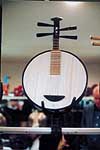|
Dear Moon,
How flattering that you've taken a shine to one of the
Middle Kingdom's more subtle contributions to world
civilization. Your ever-enlightening Ayi is more than
happy to answer your question concerning the beautiful
and little understood music makers of the Motherland.

First, the basics. Chinese traditional
musical instruments are divided into eight distinct
groups, based upon the eight trigrams of the Book of
Changes. Each trigram corresponds to a group of instruments,
the groups being silk, bamboo, metal, stone, gourd,
clay, leather and wood. The two most important groups
are bamboo and silk, thus bamboo and silk have come
to symbolize traditional Chinese music.
The most well known instruments are the erhu (two-stringed
opera violin), the zheng or qinzheng (known in the west
as a zither), the pipa or Chinese Moon Lute; the suona--a
horn traditionally used at weddings; the di--a type
of flute, and the xiao which is a wind instrument like
a flute played vertically in the fashion of a western
recorder.
The erhu resembles a violin crossed with a small drum.
It has a range of about three octaves. The erhu has
two silk strings, and a small drum-like body covered
by python skin. The word 'hu' indicates the instrument's
origins in the north among the 'Hu' people--known to
Westerners as the 'Huns'.
The pipa is made of wood, is traditionally four-stringed,
and has twelve 'stops' (or frets) along the neck. The
sound is slightly different from, but reminiscent of
a western guitar.
The zheng dates from the Warring States Period (475-221
BC). The instrument as a variety of string variations,
from 19 to 26, the original version having 21. Over
the years, rulers have added or reduced the number of
strings on the instrument used in their court orchestras
in order to be remembered in history for their own personal
style. The instrument is played with two hands. The
left hand acts to modulate the tone by pressing, rubbing
and pushing on the silk strings, while the right hand
is used to pluck them. The zheng is most often used
to accompany a person singing or to accompany poetry
recitals. This instrument is also quite popular in Japan
and some ignorant people actually mistake it for a Japanese
invention.
The suona, a seven or eight-holed flute-like horn is
still featured at Chinese weddings, where its high,
sharp tones are used to annoy the drunks until a big
enough fight breaks out to serve as entertainment. Lastly,
the flute-like xiao is played vertically much like a
recorder.
There is a legend that a man was walking along the edge
of a bamboo forest when he heard a beautiful sound,
and when he investigated, he found that a bamboo shaft
had split. As the wind blew through the split bamboo,
the sound produced was so beautiful that the man, named
Xiao, cut another bamboo shaft and fashioned a flute
from it, thus giving the instrument its name. The xiao
traditionally has six holes, five on top and one on
the bottom, and is generally 70-80 centimeters long.
The di is played horizontally in similar fashion to
a western flute. There are six finger holes for playing,
three holes for each hand. The instrument has a reed-paper
covering a hole between the mouth hole and the highest
finger hole, and the membrane serves to give the di
a reedy and bright timbre. There are many different
sizes of the flute made to facilitate key changes. The
playing range of each spans nearly two octaves plus
a fifth. There are over 600 different traditional Chinese
musical instruments, but your Ayi is too busy to discuss
them all, especially since many are simply variations
on these basic forms. There are bells, gongs, clappers,
and gourd instruments, but they all fall in the basic
categories I've outlined. If you understand these basic
instruments, which are the most common, it will increase
your appreciation of the beautiful music that has been
composed for them over millennia.
|



